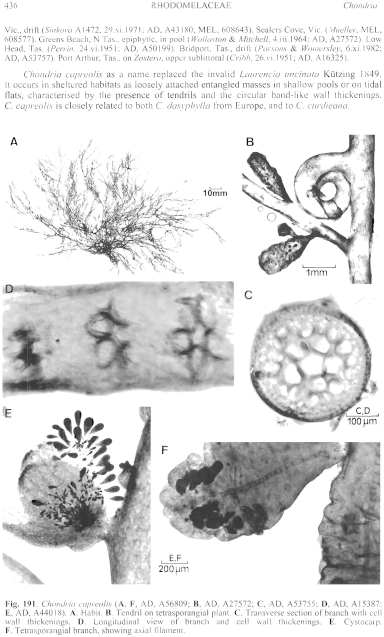|
|
|
|
|
|||||||||||
|
Electronic Flora of South Australia Species Fact Sheet
Phylum Rhodophyta – Family Rhodomelaceae – Tribe Chondrieae
Synonym
Laurencia uncinata Kützing 1849: 852; 1865: 16, pl. 44a, b. J. Agardh 1863: 811. De Toni 1903: 808. [NON L. uncinata Zanardini 1847: 201.]
Thallus (Fig. 191A) brown-red, fading to yellow-brown, (8–) 10–20 cm high, lower branches entangled and adhering by tendrils (Fig. 191B), upper branches irregularly radially branched for 3–4 orders, without axillary branches, branches terete, varying in robustness; lower branches 0.5–1 (–2) mm in diameter, grading to 0.3–1 mm in diameter in upper, basally constricted, branchlets. Attachment by tendrils and small holdfasts to host seagrasses or algae; mainly epiphytic, possibly epilithic. Structure. Apices slightly to distinctly depressed, with 5 pericentral cells (Fig. 191C) rapidly developing the cortex, mature epidermal cells 20–40 µm in diameter and L/D (1–) 2.5–6. Mature branches with no or few rhizoids. Cell wall thickenings (Fig. 191C, D) usually present, forming 2–3 (–4) circular bands around the wall, later becoming lobed but not hooked. Trichoblasts 1–2 mm long. Cells with discoid to elongate rhodoplasts.
Reproduction: Procarps as for the genus. Carposporophytes with a basal fusion cell and branched gonimoblast bearing clavate terminal carposporangia 50–90 µm in diameter. Cystocarps (Fig. 191E) ovoid, 1–1.2 mm in diameter, with a lower swelling but not a basal spur; pericarp ostiolate, with 12–16 erect filaments, two cells thick, ecorticate. Spermatangia unknown.
Tetrasporangia (Fig. 191F) in lesser branchlets, borne adaxially on 1 (–2) pericentral cells per axial cell, 200–250 µm in diameter.
Type from Tasmania; holotype in L, 941, 119...39.
Selected specimens: Wallaroo, S. Aust., on shallow reef (Watson, Jan. 1983; AD, A53755). Point Turton, S. Aust., on Caulocystis, 3–5 m deep (Kraft, 17.ix.I 973; AD, A44018). American R. inlet, Kangaroo I., S. Aust., drift at jetty (Womersley, 25.viii.1963; AD, A26770). Muston, American R. inlet, Kangaroo I., S. Aust., upper sublittoral (Womersley, 27.viii.1950; AD, A15387). Port MacDonnell, S. Aust., drift (Womersley, 17.x.1983; AD, A53713) and just below low tide in harbour (Womersley, 16.x.1985; AD, A56809 "Marine Algae of southern Australia" No. 309). Clifton Springs, Corio Bay, Vic., drift (Sinkora A1472, 29.xi.1971; AD, A43180; MEL, 608643). Sealers Cove, Vic. (Mueller, MEL, 608577). Greens Beach, N Tas., epiphytic, in pool (Wollaston & Mitchell, 4.iii.1964; AD, A27572). Low Head, Tas. (Perrin, 24.vi.1951; AD, A50199). Bridport, Tas., drift (Parsons & Womersley, 6.xi.1982; AD, A53757). Port Arthur, Tas., on Zostera, upper sublittoral (Cribb, 26.vi.1951; AD, A16325).
Distribution: Point Turton, S. Aust., to Westernport Bay, Vic., and N and SE Tasmania.
Taxonomic notes: Chondria capreolis as a name replaced the invalid Laurencia uncinata Kützing 1849. It occurs in sheltered habitats as loosely attached entangled masses in shallow pools or on tidal flats, characterised by the presence of tendrils and the circular band-like wall thickenings. C. capreolis is closely related to both C. dasyphylla from Europe, and to C. curdieana.
References:
AGARDH, J.G. (1863). Species Genera et Ordines Algarum. Vol. 2, Part 3, pp. 787–1291. (Gleerup: Lund.)
DE TONI, G.B. (1903). Sylloge Algarum omnium hucusque Cognitarum. Vol. 4. Florideae. Sect. 3. pp. 775–1521 + 1523–1525. (Padua.)
GORDON-MILLS, E.M. & WOMERSLEY, H.B.S. (1984b). Cell wall thickenings in the taxonomy of Chondria and Husseyella (Rhodomelaceae, Rhodophyta) from southern Australia. Hydrobiologia 116/117, 224–226.
GORDON-MILLS, E.M. & WOMERSLEY, H.B.S. (1987). The genus Chondria C. Agardh (Rhodomelaceae, Rhodophyta) in southern Australia. Aust. J. Bot. 35, 477–565.
KÜTZING, F.T. (1849). Species Algarum. (Leipzig.)
KÜTZING, F.T. (1865). Tabulae Phycologicae. Vol. 15. (Nordhausen.)
ZANARDINI, G. (1847). Notizie intorno alle cellulari marine della lagune e de'littorali di Venezia (1). Mem. R. Inst Veneto Sci. Lett. Art. 6, 185–262.
The Marine Benthic Flora of Southern Australia Part IIID complete list of references.
Publication:
Womersley, H.B.S. (24 February, 2003)
The Marine Benthic Flora of Southern Australia
Rhodophyta. Part IIID. Ceramiales – Delesseriaceae, Sarcomeniaceae, Rhodomelaceae
Reproduced with permission from The Marine Benthic Flora of Southern Australia Part IIID 2003, by H.B.S. Womersley. Australian Biological Resources Study, Canberra. Copyright Commonwealth of Australia.
Illustration in Womersley Part IIIA, 2003: FIG. 191.

Figure 191 enlarge
Fig. 191. Chondria capreolis (A, F, AD, A56809; B, AD, A27572; C, AD, A53755; D, AD, A15387; E, AD, A44018). A. Habit. B. Tendril on tetrasporangial plant. C. Transverse section of branch with cell wall thickenings. D. Longitudinal view of branch and cell wall thickenings. E. Cystocarp. F. Tetrasporangial branch, showing axial filament.

|
Email Contact: State Herbarium of South Australia |

|